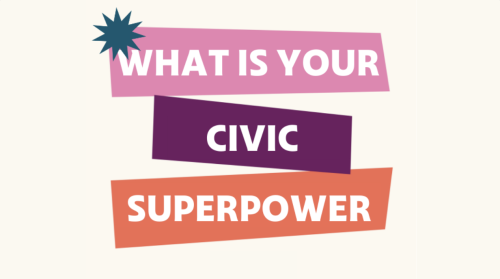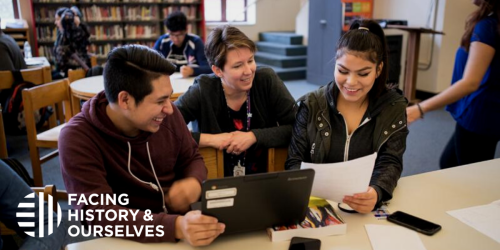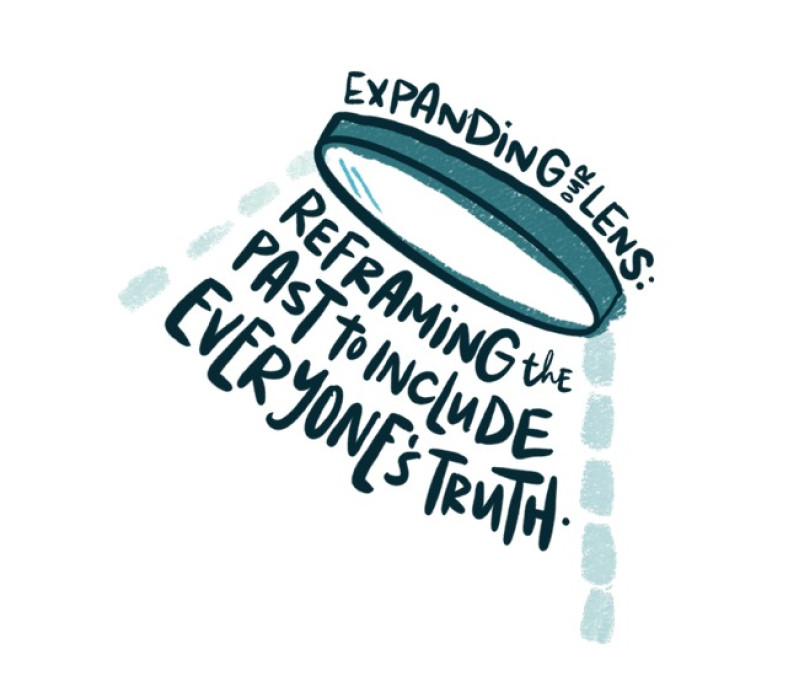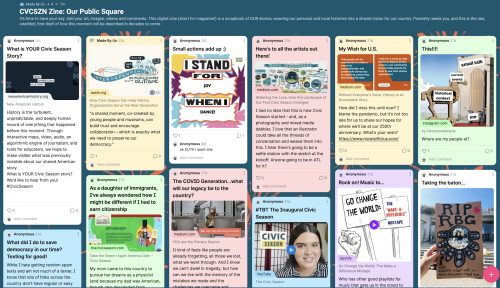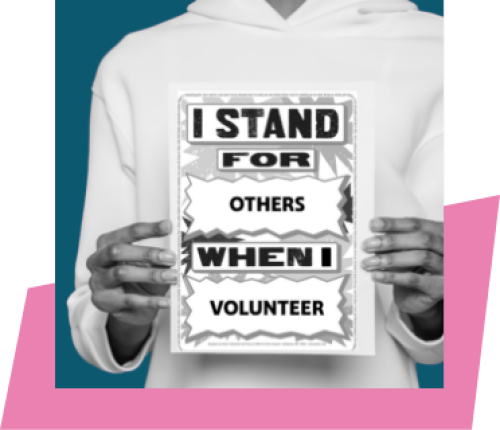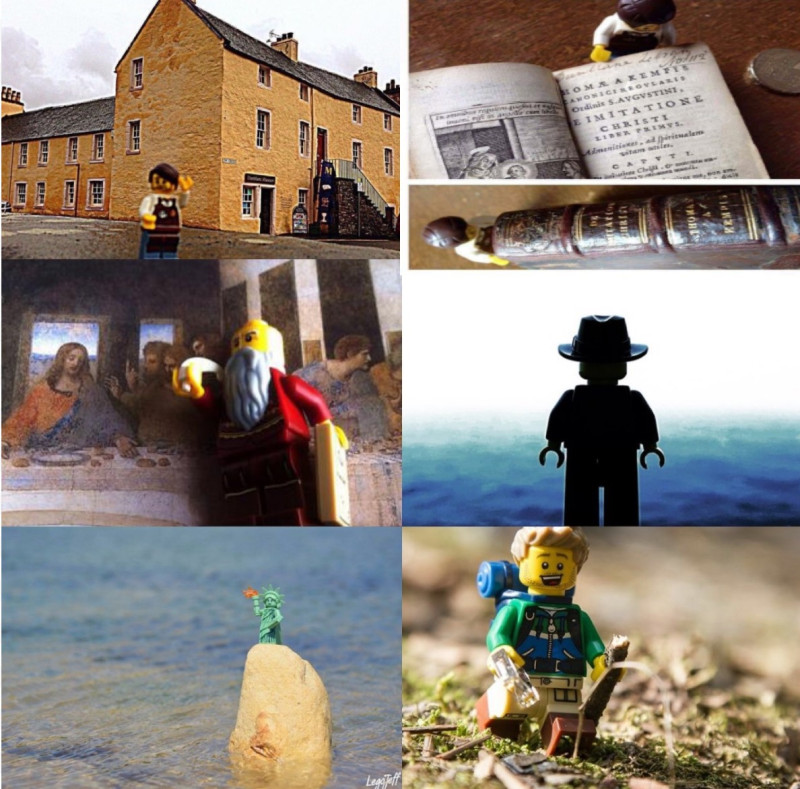This work by New American History is licensed under a Attribution-NonCommercial-ShareAlike 4.0 (CC BY-NC-SA 4.0) International License. Permissions beyond the scope of this license may be available at newamericanhistory.org.
Civic Season 2022: What is YOUR Civic Superpower?
View Student Version
Standards
C3 Framework: D2.Civ.1.6-8, D2.Civ.5.9-12National Council for Social Studies: Culture, and individuals, Groups, and InstitutionsNational Geography Standards: Standard 6 How culture and experience influence people's perceptions of places and regions
EAD Roadmap:
DESIGN CHALLENGES Motivating Agency, Sustaining the Republic Balancing the Concrete & the Abstract PRIMARY THEME Our Changing Landscapes SECONDARY THEME Our Changing LandscapesRELATED DRIVING QUESTIONS HDQ1.3A When and where have leaders and change-makers emerged in American history? What has motivated them and prepared them for civic engagement? HDQ1.3C How has civic participation changed throughout American history? How has it stayed the same? CDQ1.3C How can I take advantage of digital tools for civic participation safely and productively?
Council for Accreditation of Educator Preparation (CAEP)Standard 1. Content and Pedagogical Knowledge. The provider ensures that candidates develop a deep understanding of the critical concepts and principles of their discipline and, by completion, are able to use discipline-specific practices flexibly to advance the learning of all students toward attainment of college-and career-readiness standards. Candidate Knowledge, Skills, and Professional Dispositions.1.1 Candidates demonstrate an understanding of the 10 InTASC standards at the appropriate progression level(s) in the following categories: the learner and learning; content; instructional practice; and professional responsibility.
Teacher Tip: If exploring the Civic Season as part of a summer learning program, or extending it into the next school year, think about what students should be able to KNOW, UNDERSTAND and DO at the conclusion of this learning experience. A brief exit pass or other formative assessment may be used to assess student understandings. Setting specific learning targets for the appropriate grade level and content area will increase student success.
Suggested Grade Levels: Upper Elementary, Middle, High School, Post-Secondary (4-16)
Suggested Timeframe: 5 sessions, 30 minutes each or multiple days, self-guided
Suggested Materials: Internet access via laptop, tablet, or mobile device
Key Vocabulary
Avatar - an icon or character used to represent a person online
Civic - having to do with citizenship
Public Square - a public gathering place within a community, a shared space for community meetings
Redlining - the practice of denying a creditworthy applicant a loan for housing in a certain neighborhood even though the applicant may otherwise be eligible for the loan. The term refers to the presumed practice of mortgage lenders of drawing red lines around portions of a map to indicate areas or neighborhoods in which they do not want to make loans.
Solutionary - characterized by solving problems in a strategic manner that aims not to harm one group while helping another
StoryMap - a web-based map integrating maps, legends, text, images, and multimedia elements to help users explore content and visualize data.
‘Zine - short for magazine, a self-published print or digital publication, or scrapbook of curated or crowdsourced content appealing to a small audience
Read for Understanding
Teacher Tips:
We hope schools will introduce students to the Civic Season before the end of the school year and encourage them to participate with their friends and family as it is safe for them to do so. Some schools may choose to integrate the events and activities, both face-to-face and place-based into their summer learning programs. We also encourage faith-based organizations, scout troops, summer camps, and other youth-focused programs to join in the fun! Please help us spread the word!
This Learning Resource includes language in the body of the text to help adapt to a variety of educational settings, including remote learning environments, face-to-face instruction, and blended learning.
If you are teaching or joining the Civic Season remotely, consider using video conferencing to allow students to explore in partners or small groups. Digital tools such as Google Docs or Google Slides may also be used for collaboration. Rewordify helps make a complex text more accessible for those reading at a lower Lexile level while still providing a greater depth of knowledge. Canva and Visme are free graphic image editing tools for creating social media posts. The Civic Season is an online campaign sponsored by Made By Us. For more information on Solutionary Thinking, visit the Institute for Humane Education site.
This Learning Resource follows a variation of the 5Es instructional model, and each section may be taught as a separate learning experience, or as part of a sequence of learning experiences. We provide each of our Learning Resources in multiple formats, including web-based and an editable Google Doc for educators to teach and adapt selected learning experiences as they best suit the needs of your students and local curriculum. You may also wish to embed or remix them into a playlist for students working remotely or independently.
For Students:
The 2nd Annual Civic Season from our friends at the Made by Us coalition is about Finding Your Civic Superpower! This includes motivating young people to make space for more telling stories from the past, more voices from the present, and more input on what an annual tradition for civic participation could look like. When the Civic Season kicks off in June 2022, you can explore a multitude of offerings and activities filtered by topic, location, and format, designed to support your own personal exploration into history and democracy. What role will you play?
As museums and historic sites remain open and more citizens ages 12 and older are vaccinated, we offer The Civic Season, a “choose your adventure” experience from Flag Day to Juneteenth to July 4th, and beyond. As we see more people return to visiting local historical sites and museums, be sure to check beforehand to see what public health precautions are currently required. These may include mask-wearing, social distancing, and admissions requirements such as timed entry or pre-registration. Virtual offerings for those living in remote areas or with limited access to participating museums and organizations are ways for everyone to participate.
Engage:
What is the Civic Season, and why should I participate?
Each generation shapes culture and conversation. Today’s young adults are seeking out trusted information on democracy and history to inform civic action. Made By Us is a coalition of 150+ museums, historic sites, and partner orgs joining forces to serve the next generation – meeting curiosity with credibility. Civic Season is one way to roll out the welcome mat for the future inheritors of the United States, putting history in their hands as a tool for informed, inspired civic participation.
Last summer, the Made by US coalition teamed up with New American History and other partner organizations to launch the first-ever Civic Season. Here is a brief recap of what you missed! (View video, “The Civic Season.”)
We created lots of fun activities for you and your classmates to enjoy last summer, but we also heard back from many of you who are still using some of these in your classrooms and in other student-centered organizations, too. We think that is terrific!!
This summer, we will build on these same themes of civic engagement, finding your voice, expanding our lens, and reframing the past to include everyone’s truth. This includes a variety of in-person and virtual opportunities.
Museums, historical sites, and partner organizations are hosting events all summer long, starting with a variety of kick-off events on June 12th! Take a few minutes to explore the website and check out some of the upcoming events planned. We hope you will join us!
- What ideas or themes about the Civic Season resonate with you most (from the website or the video)?
- Who might you enlist as allies in exploring these themes?
- What event or activity would you like to try to attend or participate in first?
- What questions do you still have about the Civic Season?
We would love to see what you created - please share your work if your teacher or a trusted adult permits. You may email us at editor@newamericanhistory.org or share via social media (links on our pages). Be sure to tag us and add #CivicSeason!
Your teacher may ask you to record your answers on an exit ticket.
Explore:
What is YOUR Civic Superpower?
Still not sure how you might fit into the Civic Season? No worries—we’ve got you covered! Part of the goal of the Civic Season is to mobilize the next generation of solutionary thinkers and civic leaders to find their voice and imagine ways for them to best connect with our past, take action in the present, and shape the future. To help kickstart this process, we present the “What is YOUR Civic Superpower?” Quiz! Ready to find out what strengths you bring to the table? Take the quiz below, then read the descriptions of each “superpower” as described below the quiz to get inspired by figures in the past – and learn how you can take action today.
Now that you have identified your Civic Superpower, it’s time to think about how you might share your powers with others. Take a few minutes to read this article from our friends at Facing History. Make a copy of and use this interactive slide deck to select a Civic Season prompt and picture frame to help you begin to share your story.
Create your own Civic Season Avatar (use free apps like Emojipedia, and Bitmoji, use your own image or create something totally new!). Use one or more of the slides to tell us about your Civic Superpowers! We would love to see what you created - please share your work if your teacher or a trusted adult permits. You may email us at editor@newamericanhistory.org or share via social media (links on our pages). Be sure to tag us and add #CivicSeason!
Your teacher may ask you to record your answers on an exit ticket.
Explain:
What is your Civic Season Story?
The Civic Season is about expanding the lens, making space for more stories from the past, more voices from the present, and more input on what an annual tradition for civic participation could look like.
Big civic questions and solutions to civic problems require great communication. Speaking your truth and making space for the stories of the past helps us lean into building better, more caring, and connected communities. We like to explore telling these stories in a variety of ways.
One way we tell stories is with maps! One of our favorite tools for sharing compelling narratives is StoryMaps. Check out a couple of StoryMaps from American Panorama, our Digital Atlas of American History.
Southern Journey is actually three StoryMaps rolled into one, tracing patterns of human migration across the American South from 1790 to 2020. Pick one or more sections of the map and explore stories of Black, white, Indigenous, Asian American, and Latin American peoples who all helped shape our nation’s past!
The lines that shape our cities tells the story of the unintended consequences of discriminatory lending practices known as redlining, and how future generations continue to be harmed through a lack of affordable housing, access to nutritious food and affordable healthcare, and environmental factors including poor air quality and climate change. A cautionary tale blending history, civics, and environmental/health sciences.
- What are your thoughts about the StoryMap platform as a storytelling tool?
- What elements of one or more of the maps you explored did you most enjoy?
- What questions do you have about StoryMaps?
- What stories might you tell using a platform like StoryMaps?
- What stories might you find in your own backyard, your neighborhood, or your community?
You can work with your teacher, club, organization leader, or another trusted adult, to set up your own FREE ArcGIS online account and start telling your own stories!
We would love to hear from you as you are planning your storytelling ideas.
- What local stories might you tell?
- What are you curious about in your own community?
- How did the streets or buildings in your town get their names?
- How can we help?
We would love to see what you created - please share your work if your teacher or a trusted adult permits. You may email us at editor@newamericanhistory.org or share via social media (links on our pages). Be sure to tag us and add #CivicSeason!
Your teacher may ask you to record your answers on an exit ticket.
Elaborate:
What path might you choose to explore and illuminate your Civic Season journey?
The Civic Season is truly a “choose your own adventure” experience. With multiple pathways to explore, choose from a variety of virtual, interactive, and in-person experiences. You can also filter your search by location to find events hosted near you, or by topics of interest.
Scroll through some of these experiences on the Civic Season website under the Activities and Events menu. Choose one or more events to explore. We found this gem under both the “Independence + Freedom” AND “African American Experience” pathways.
Once you have explored a few pathways, you may want to add your thoughts to the Civic Season Public Square, a digital version of a ‘Zine (short for magazine) created by our Millenial and GenZ Youth Advisors and Design Fellows (you met some of them in the Civic Season Year One video!). Feel free to post your reflections on which Civic Season pathways you explored, and revisit and post throughout the Civic Season to share your experiences with us and with the world.
Prefer to record an audio message?
Share with Storycorps
This is our moment in history - which makes us the primary source. We’ve partnered with StoryCorps and the Civic Season to capture stories of those who join and build the Civic Season through the nation’s 250th – in a collection that lives at the Library of Congress.
Your teacher may ask you to record your answers on an exit ticket.
Extend:
How might you explore the Civic Season using creativity and artistic expression?
Artists use visual, performing and fine arts to convey messages of protest, support, and freedom, as well as to entertain or celebrate. This year the Civic Season is partnering with the Show of Hands team at the historic Globe Collection and Press to help you share what you stand for with this iconic, custom Civic Season poster generator.
Toys and photography can become creative storytelling tools as a form of visual artistic expression. “Legography” (think Legos + photography) have been a favorite variation of what some artists call Toy Photography, using small Lego mini-figures or other small toys/action figures to share your travels or tell important stories.
This Civics Season, we want to challenge you to join our #CivicSeason #BuildAWorldOfPlay Challenge. We are partnering with the Lego Foundation and the History Co:Lab to challenge all Civic Season participants to document their experiences visiting museums and historical sites and exploring their own communities for those hidden stories in their own backyard through play and photography. Join the Build A World of Play campaign and help us tell the world about your adventures exploring history. Here are a few examples we found across the web following the hashtag #Legography.
For each Civic Season event you attend, museum you visit, or local exploration, consider taking along your favorite childhood toy or action figure (or borrow some from a younger family member, friend, or community member.) Pose your toy of choice to help illustrate the Civic Season activity you are pursuing with your newly found Civic Superpowers.
Take a few Legos or other small toys/action figures along on a family vacation or trip to the local park, and find those hidden histories along the way. You may use any mobile device such as a phone, tablet, or camera to capture your story. Post your digital images on your favorite social media site (or ask a trusted grownup to help you post them) and be sure to include #CivicSeason #BuildAWorldOfPlay and identify your location.
We can’t wait to see where your adventures will take you!
Your teacher may ask you to record your answers on an exit ticket.
Citations:
Art by Corrina Keeling. LoveLettersForEverybody.caCC BY-NC-ND 4.0 (Attribution-NonCommercial-NoDerivatives 4.0 International).
Ayers, Edward L., Justin Madron, and Nathaniel Ayers. “Southern Journey: Migrations of the American South, 1790-2020.” Southern Journey, a StoryMap. Digital Scholarship Lab, University of Richmond, November 2020. https://dsl.richmond.edu/southernjourney/.
Globe Collection. “Globe Collection and Press.” Globe Collection and Press MICA. Maryland Institute College of Art, 2022. https://www.mica.edu/research/globe-collection-and-press/.
“Legography.” Legography Flickr Images Group Pool. Yahoo!, December 2012. https://www.flickr.com/groups/legography/pool/.
Made By US. “Share with StoryCorps: What Do You Stand for?” Medium. (History) Made By Us, May 20, 2022. https://medium.com/history-made-by-us/share-with-storycorps-what-do-you-stand-for-719bf4a65b31.
Murphy, Karen. “How to Find Your Civic Superpower.” Facing History and Ourselves. Facing History and Ourselves, 2022. https://www.facinghistory.org/stories/how-find-your-civic-superpower.
“Power of Play.” Power of Play The History Co:Lab. The History Co:Lab, 2020. https://www.got-history.org/power-of-play.
“The Civic Season: Juneteenth - July 4th, 2021.” Made By Us. Made By US, 2021. https://historymadebyus.com/civicseason.
“The Civic Season 2022.” The Civic Season. Made by US, May 18, 2022. https://www.thecivicseason.com/.
View this Learning Resource as a Google Doc




